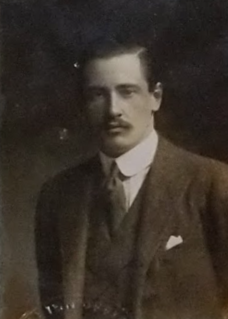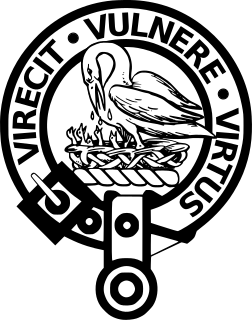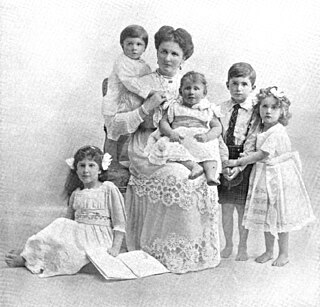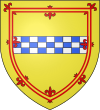
The House of Stuart, originally Stewart, was a royal house of Scotland, England, Ireland and later Great Britain. The family name comes from the office of High Steward of Scotland, which had been held by the family progenitor Walter fitz Alan. The name Stewart and variations had become established as a family name by the time of his grandson Walter Stewart. The first monarch of the Stewart line was Robert II, whose male-line descendants were kings and queens in Scotland from 1371, and of England and Great Britain from 1603, until 1714. Mary, Queen of Scots, was brought up in France where she adopted the French spelling of the name Stuart.

Duke of Argyll is a title, created in the Peerage of Scotland in 1701 and in the Peerage of the United Kingdom in 1892. The Earls, Marquesses, and Dukes of Argyll were for several centuries among the most powerful noble families in Scotland. As such, they played a major role in Scottish history throughout the 16th, 17th, and 18th centuries. The Duke of Argyll also holds the hereditary titles of chief of Clan Campbell and Master of the Household of Scotland.

Marquess of the County of Bute, shortened in general usage to Marquess of Bute, is a title in the Peerage of Great Britain. It was created in 1796 for John Stuart, 4th Earl of Bute.

Earl of Dumfries is a title in the Peerage of Scotland. It was originally created for William Crichton, 9th Lord Crichton of Sanquhar, in 1633, and stayed in the Crichton family until the death of the fourth countess in 1742, at which point the title passed to first the Dalrymple and then the McDouall families before finally being inherited by the Marquesses of Bute, where it remains today.

The title Earl of Moray, Mormaer of Moray or King of Moray was originally held by the rulers of the Province of Moray, which existed from the 10th century with varying degrees of independence from the Kingdom of Alba to the south. Until 1130 the status of Moray's rulers was ambiguous and they were described in some sources as "mormaers", in others as "Kings of Moray", and in others as "Kings of Alba". The position was suppressed by David I of Scotland some time after his defeat of Óengus of Moray at the Battle of Stracathro in 1130, but was recreated as a feudal earldom by Robert the Bruce and granted to Thomas Randolph, 1st Earl of Moray in 1312.

John Patrick Crichton-Stuart, 3rd Marquess of Bute, was a landed aristocrat, industrial magnate, antiquarian, scholar, philanthropist, and architectural patron.
The name Crichton originates as the name of

John Crichton-Stuart, 4th Marquess of Bute, KT, was a Scottish peer.
Sir James Stuart, 3rd Baronet, of Bute, created 1st Earl of Bute, MP, PC, was a Scottish soldier, advocate, judge and politician. He was the son of Sir Dugald Stuart, 2nd Baronet, and his wife Elizabeth Ruthven, daughter of Sir John Ruthven.

Clan Murray is a Highland Scottish clan. The chief of the Clan Murray holds the title of Duke of Atholl. Their ancestors who established the family in Scotland in the 12th century were the Morays of Bothwell. In the 16th century descendants of the Morays of Bothwell, the Murrays of Tullibardine, secured the chiefship of the clan and were created Earls of Tullibardine in 1606. The first Earl of Tullibardine married the heiress to the Stewart earldom of Atholl and Atholl therefore became a Murray earldom in 1626. The Murray Earl of Atholl was created Marquess of Atholl in 1676 and in 1703 it became a dukedom. The marquess of Tullibardine title has continued as a subsidiary title, being bestowed on elder sons of the chief until they succeed him as Duke of Atholl.

Crichton Castle is a ruined castle near the village of Crichton in Midlothian, Scotland. It is situated at the head of the River Tyne, 2 miles (3.2 km) south of the village of Pathhead, and the same distance east of Gorebridge.

Clan Crichton is a Lowland Scottish clan.

Lieutenant-Colonel Lord Ninian Edward Crichton-Stuart was a Scottish senior officer in the British Army and Member of Parliament. He was killed in action in the First World War. The second son of the Honourable Gwendolen Mary Anne Fitzalan-Howard and John Crichton-Stuart, 3rd Marquess of Bute, he entered the army in 1903 and served in the Queen's Own Cameron Highlanders and the Scots Guards as a lieutenant. After marrying he began a career in politics, serving first as a councillor on Fife County Council, Scotland. His family having close connections to the city of Cardiff in Wales, he fought and lost the January 1910 election there as a Liberal Unionist candidate. The resulting hung parliament led to a second election in December 1910, in which Crichton-Stuart won the seat.

Lord Colum Edmund Crichton-Stuart was born on 3 April 1886 and died 18 August 1957, aged 71. Lord Colum Edmund Crichton-Stuart was the fourth child of John Patrick Crichton-Stuart, 3rd Marquess of the County of Bute and the Hon. Gwendolen Mary Anne Fitzalan-Howard. He married Elizabeth Caroline Petty-Fitzmaurice, Marchioness of Lansdowne and the only daughter of Sir Edward Stanley Hope KCB and Constance C. Leslie. Lord Colum was educated at Harrow and Christ Church, Oxford University, England.

Clan Stewart is a Scottish Highland and Lowland clan. The clan is recognised by Court of the Lord Lyon; however, it does not have a Clan Chief recognised by the Lord Lyon King of Arms. Because the clan has no chief it can be considered an armigerous clan; however, the Earls of Galloway are now considered to be the principal branch of this clan, and the crest and motto of The Earls of Galloway's arms are used in the Clan Stewart crest badge. The Court of the Lord Lyon recognises two other Stewart/Stuart clans, Clan Stuart of Bute and Clan Stewart of Appin. Clan Stuart of Bute is the only one of the three clans at present which has a recognised chief.
James Stuart, 3rd Earl of Moray was the son of James Stewart, 2nd Earl of Moray and Elizabeth Stuart, 2nd Countess of Moray.

Augusta Mary Monica Crichton-Stuart, Marchioness of Bute,, was an Anglo-Irish aristocrat who was a daughter of Sir Henry Bellingham, 4th Baronet, and Lady Constance Julia Eleanor Georgiana Noel, daughter of Charles Noel, 2nd Earl of Gainsborough.
Lord Patrick James Herbert Crichton-Stuart, known as the Hon. Patrick Stuart until 1817, was a British politician.

Clan Forbes is a Highland Scottish clan from Aberdeenshire, Scotland.
William Ruthven, 1st Lord Ruthven was a Scottish nobleman and founder of the noble lines of the Ruthven family.

















